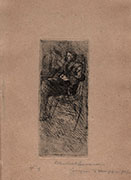Reggio Calabria 1884 - Verona 1916
Umberto Boccioni was born in Reggio di Calabria. In 1889 he attended the painting school Scuola Libera del Nudo in Rome, where he met Gino Severini and also Giacomo Balla. Balla gave him his first instruction in the techniques of Divisionist painting. In 1902 he went to Paris to study Impressionism and Cubism and in 1906 he travelled through western Russia. Then he came back to Italy, visited Padua and then moved to Venice, where he spent the winter of 1906-07 taking life-drawing classes at the Accademia di Belle Arti. He finally settled in Milan, where he met Marinetti in 1910 and became a Futurist, authoring in 1910, along with Carrà, Russolo, Balla, and Severini, the Manifesto dei pittori futuristi and the Manifesto tecnico della pittura futurista. Boccioni, along with Russolo and Carrà, was responsible for integrating the visual arts into this literary movement. The dominant figure of the group and its most important theorist, Boccioni produced, during the following five years, what is generally considered Futurism's finest artistic legacy. He moved away from a Divisionist technique and began to employ the formal vocabulary of Cubism from around 1911. The following year Boccioni became fascinated with sculpture after seeing the works of Medardo Rosso in Paris and he began to experiment with this medium. He also published a number of theoretical essays about painting and sculpture, collected in the book Pittura scultura futuriste (Dinamismo Plastico) (1914), and traveled to various European cities, organizing Futurist shows and giving lectures. He served with Marinetti and other Futurists in the First World War, and died after falling from a horse during a training exercise in 1916.
